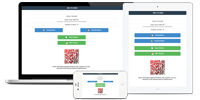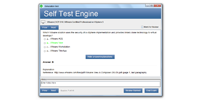OGEA-103試験の品質と価値
JPNTestのEnterprise Architecture OGEA-103模擬試験問題集は、認定された対象分野の専門家と公開された作成者のみを使用して、最高の技術精度標準に沿って作成されています。
OGEA-103の迅速なアップデート対応
OGEA-103試験に変更がございました場合は、現在の試験と一致するよう、瞬時に学習資料を更新することができます。弊社は、お客様に最高、最新のThe Open Group OGEA-103問題集を提供することに専念しています。なお、ご購入いただいた製品は365日間無料でアップデートされます。
あなたのOGEA-103試験合格を100%保証
JPNTestテスト問題集を初めて使用したときにEnterprise Architecture OGEA-103試験(TOGAF Enterprise Architecture Combined Part 1 and Part 2 Exam)に合格されなかった場合は、購入料金を全額ご返金いたします。
JPNTestでThe Open Group OGEA-103問題集をチョイスする理由
JPNTestは、1週間で完璧に認定試験を準備することができる、忙しい受験者に最適な問題集を提供しております。 OGEA-103の問題集は、The Open Groupの専門家チームがベンダーの推奨する授業要綱を深く分析して作成されました。弊社のOGEA-103学習材料を一回のみ使用するだけで、The Open Group認証試験に合格することができます。
OGEA-103はThe Open Groupの重要な認証であり、あなたの専門スキルを試す認定でもあります。受験者は、試験を通じて自分の能力を証明したいと考えています。 JPNTest TOGAF Enterprise Architecture Combined Part 1 and Part 2 Exam は、Enterprise Architectureの122の問題と回答を収集して作成しました。TOGAF Enterprise Architecture Combined Part 1 and Part 2 Examの知識ポイントをカバーし、候補者の能力を強化するように設計されています。 JPNTest OGEA-103受験問題集を使用すると、TOGAF Enterprise Architecture Combined Part 1 and Part 2 Examに簡単に合格し、The Open Group認定を取得して、The Open Groupとしてのキャリアをさらに歩むことができます。
ダウンロード可能なインタラクティブOGEA-103テストエンジン
Enterprise Architectureの基礎準備資料問題集には、Enterprise Architecture OGEA-103試験を受けるために必要なすべての材料が含まれています。詳細は、正確で論理的なものを作成するために業界の経験を常に使用しているEnterprise Architecture によって研究と構成されています。
The Open Group TOGAF Enterprise Architecture Combined Part 1 and Part 2 認定 OGEA-103 試験問題:
1. Complete the following sentence. In the ADM documents which are under development and have not undergone any formal review and approval process are_______________.
A) Called ''draft''
B) In between phases
C) Known as ''Version 0.1''
D) Invalid
2. Scenario
Your role is that of an Enterprise Architect, reporting to the Chief Enterprise Architect, at a technology company.
The company uses the TOGAF standard as the method and guiding framework for its Enterprise Architecture (EA) practice. The Chief Technology Officer (CTO) is the sponsor of the activity. The EA practice uses an iterative approach for its architecture development. This has enabled the decision-makers to gain valuable insights into the different aspects of the business.
The nature of the business is such that the data and the information stored on the company systems is the company's major asset and is highly confidential. The company employees travel a lot for work and need to communicate over public infrastructure. They use message encryption, secure internet connections using Virtual Private Networks (VPNs), and other standard security measures. The company has provided computer security awareness training for all its staff. However, despite good education and system security, there is still a need to rely on third-party suppliers for infrastructure and software.
The Chief Security Officer (CSO) has noted an increase in ransomware (malicious software used in ransom demands) attacks on companies with a similar profile. The CSO recognizes that no matter how much is spent on education and support, the company could be a victim of a significant attack that could completely lock them out of their important data.
A risk assessment has been completed, and the company has looked for cyber insurance that covers ransomware. The price for this insurance is very high. The CTO recently saw a survey that said 1 out of 4 businesses that paid ransoms could not get their data back, and almost thesame number were able to recover the data without paying. The CTO has decided not to get cyber insurance to cover ransom payment.
You have been asked to describe the steps you would take to strengthen the current architecture to improve data protection.
Based on the TOGAF standard, which of the following is the best answer?
A) You would request an Architecture Compliance Review with the scope to examine the company's ability to respond to ransomware attacks. You would identify the departments involved and have them nominate representatives. You would then tailor checklists to address the requirement for increased resilience. You would circulate to the nominated representatives for them to complete. You would then review the completed checklists, identifying and resolving issues. You would then determine and present your recommendations.
B) You would monitor for technology updates from your existing suppliers that could enhance the company's capabilities to detect, react, and recover from an IT security incident. You would prepare and run a disaster recovery planning exercise for a ransomware attack and analyze the performance of the current Enterprise Architecture. Using the findings, you would prepare a gap analysis of the current Enterprise Architecture. You would prepare change requests to address identified gaps. You would add the changes implemented to the Architecture Repository.
C) You would assess business continuity requirements and analyze the current Enterprise Architecture for gaps. You would recommend changes to address the situation and create a change request. You would engage the Architecture Board to assess and approve the change request. Once approved, you would create a new Request for Architecture Work to begin an ADM cycle to implement the changes.
D) You would ensure that the company has in place up-to-date processes for managing change to the current Enterprise Architecture. Based on the scope of the concerns raised, you recommend that this be managed at the infrastructure level. Changes should be made to the baseline description of the Technology Architecture. The changes should be approved by the Architecture Board and implemented by change management techniques.
3. Consider the following descriptions of deliverables consumed and produced across the TOGAF ADM cycle.
General rules and guidelines, intended to be enduring and seldom amended, that inform and support the way in which an organization sets about fulfilling its mission
The joint agreements between development partners and sponsors on the deliverables, quality, and fitness-for-purpose of an architecture.
A document that is sent from the sponsoring organization to the architecture organization to trigger the start of an architecture development cycle
A set of quantitative statements that outline what an implementation project must do in order to comply with the architecture.
Which deliverables match these descriptions?
A) 1 Architecture Principles -2 Architecture Contracts - 3 Request for Architecture Work - 4 Architecture Requirements Specification
B) 1 Architecture Contracts - 2 Architecture Requirements Specification - 3 Architecture Vision - 4 Architecture Principles
C) 1 Architecture Requirements Specification -2 Architecture Principles - 3 Architecture Vision - 4 Architecture Contracts
D) 1 Architecture Principles -2 Architecture Contracts - 3 Architecture Requirements Specification-4 Request for Architecture Work
4. You are working as an Enterprise Architect within an Enterprise Architecture (EA) team at a large government agency with multiple divisions. The agency has a well-established EA practice and follows the TOGAF standard as its method for architecture development. The government has mandated that the agency prepare for an "AI-first" world.
The agency wants to determine the impact and role of AI in its future services. The CIO has approved a Request for Architecture Work to explore the use of AI in services. Some leaders are concerned about reliance on AI, security, and employees' need to acquire new skills.
The EA team leader seeks suggestions on managing the risks associated with a new architecture for the AI- first project. Based on the TOGAF standard, which of the following is the best answer?
A) Separate stakeholders into groups and categorize them. Develop models for each group and verify that their concerns are addressed in Phase G, Implementation Governance.
B) Conduct an analysis of stakeholders, documenting their concerns and recording them in the Architecture Vision document. Risks should be recorded in the Architecture Requirements Specification and reviewed regularly.
C) Create an organization map to show the links between different agency parts. Hold a meeting to teach stakeholders to interpret the models. Manage risks as part of Security Architecture development.
D) Identify key stakeholders and develop a Communication Plan that addresses their needs. Ensure the architecture addresses risk management and summarizes features of the architecture.
5. What are the four architecture domains that the TOGAF standard deals with?
A) Application, Data, Information, Knowledge
B) Baseline, Candidate, Transition, Target
C) Business, Data, Application, Technology
D) Capability, Segment, Enterprise, Federated
質問と回答:
| 質問 # 1 正解: A | 質問 # 2 正解: A | 質問 # 3 正解: D | 質問 # 4 正解: B | 質問 # 5 正解: C |


 471 お客様のコメント
471 お客様のコメント





